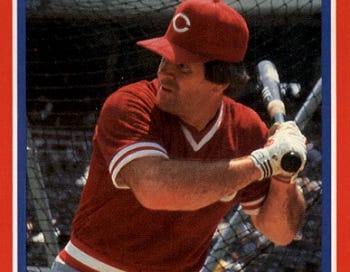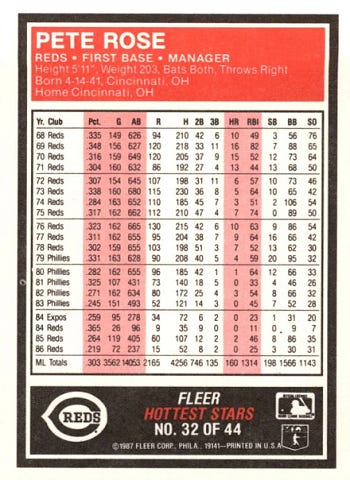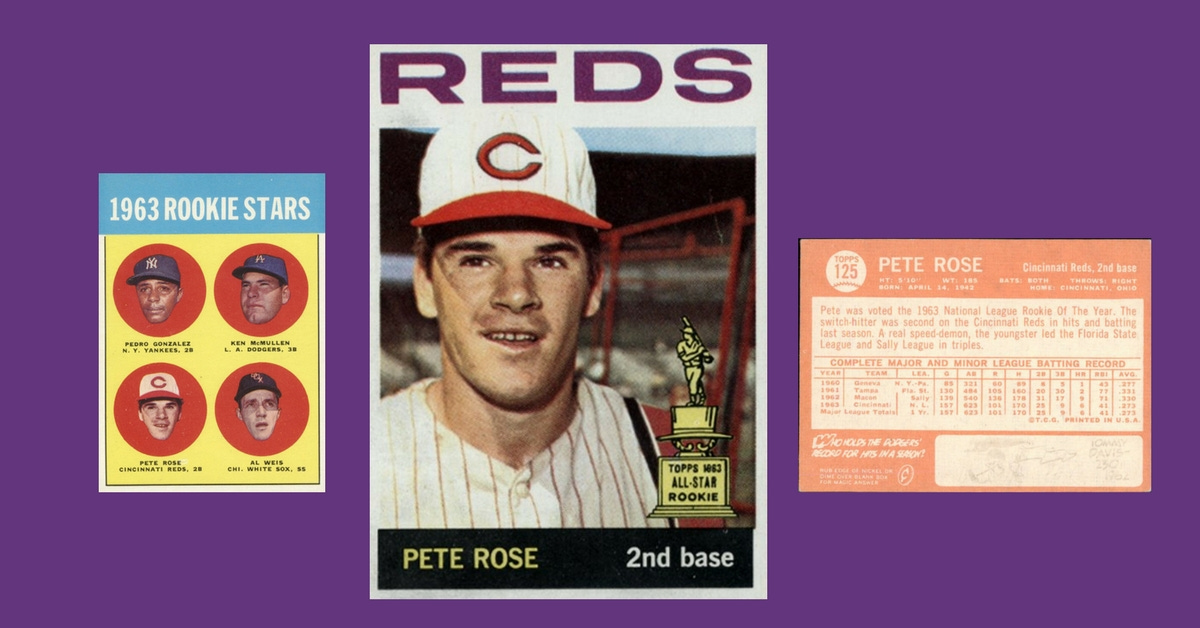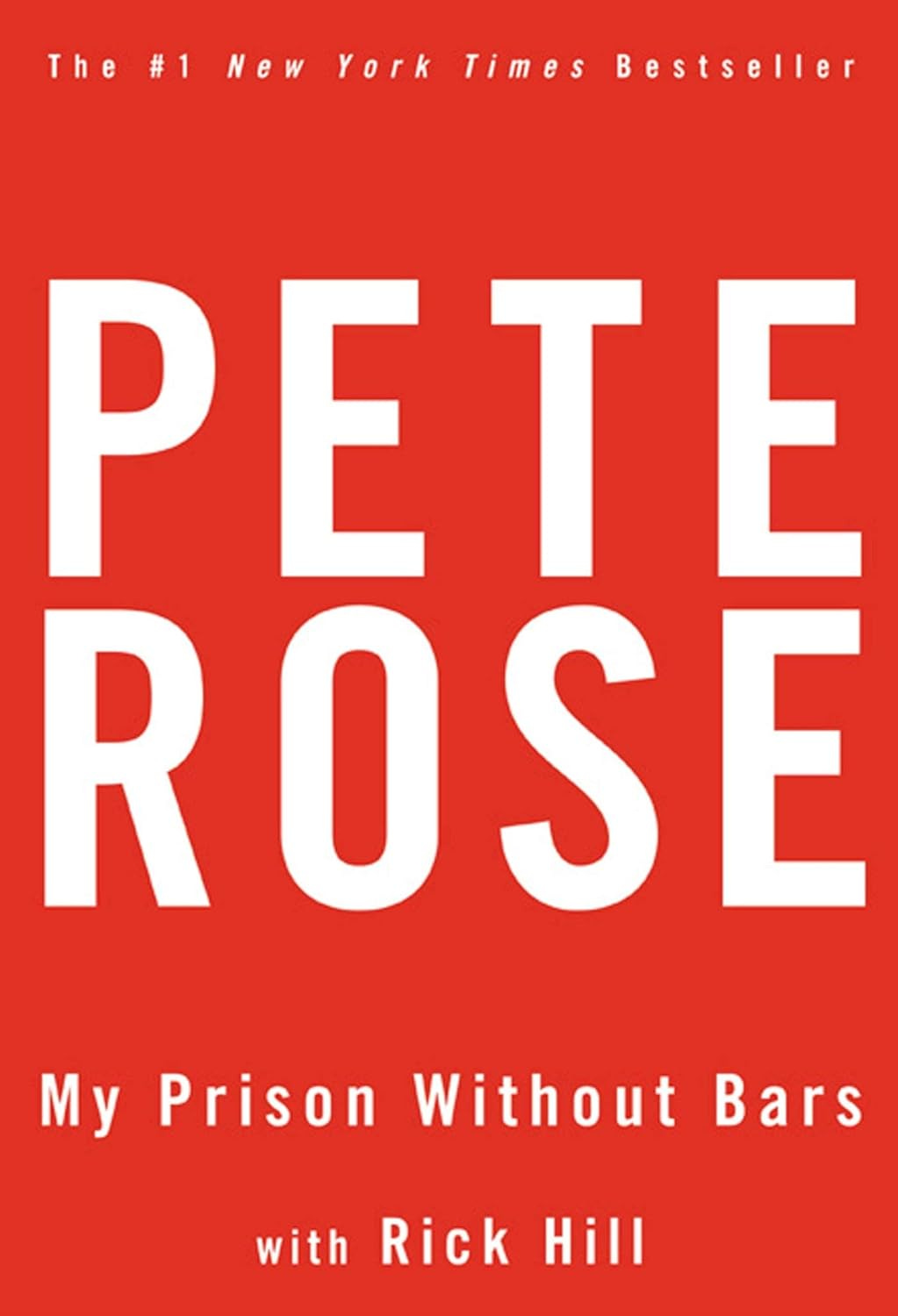Pete Rose Had a Prescription for Hobby Success
And an over-the-counter career-capper baseball card
Note: When you click on links to various merchants in this newsletter and make a purchase, this can result in this newsletter earning a commission. Affiliate programs and affiliations include, but are not limited to, the eBay Partner Network and Amazon Associates.
1987 Fleer Baseball’s Hottest Stars Pete Rose (#32) - Card of the Day
(affiliate link)
Today is a big day in Reds Country every year, and this year, it’s a fairly momentous day for baseball overall — even if you didn’t realize it and no matter which side of the fence you view it from.
What “fence” is that, you say? Why, the Pete Rose fence, of course.
See, today is Pete Rose’s birthday, the first one since he died last September. And the Rose fence has all sorts of ways to plop fans and collectors on one side or the other. He was a hustler in many senses of the word, a sports hero who (at least eventually) rolled up his sleeves and let the world glimpse most of his ugliest character warts.
As for me, Rose has been a constant almost since I ripped my first wax pack in anger lo, those many decades ago.
He was there as I rooted on the Phillies in the 1983 NLCS and World Series during the first October that really mattered to me.
He was there when my dad realized I was tumbling into the diamond world and shared his memories of the Big Red Machine…even though Dad hated baseball and thought sports should involve blood or broken bones on at least a few plays per game.
Rose wasn’t there when I saw my first game at Riverfront Stadium in June 1984, but he was there a few months later when my Reds suddenly became exciting again.
And, of course, Rose was there as I entered my senior year of high school in the late summer of 1989 to give me an early lesson in confusion and disappointment. Memories of that August will always swirl as a mix of marching band and girl-next-door Tammy Jo Lambeau (name changed for my protection) and driving and football games and I-gotta-get-out-of-here-itis and…Pete Rose turning villain.
Rose was never fully my favorite player — that was and is Mike Schmidt.
Rose wasn’t my favorite Red during the middle 1980s, either — hello, Dave Parker!
Rose wasn’t even my favorite Reds manager — Davey Johnson is the man there, though I have high hopes that Terry Francona might supplant him, preferable sooner rather than later.
But Rose has been the most constant topic of discussion, the most adrenaline-pumping pack pull, the most baseball-y face and persona (for me, at least) for forty years running.
And on the question of Pete Rose and the Hall of Fame (not that you asked me), well, I think Pete belongs in Cooperstown, but even that has some on-the-fenceness for me.
I mean, Pete is the all-time hits leader, which pretty much cements his case in my eyes, but his statistical and qualitative cases for enshrinement have some holes. He was a classic “accumulator,” for example, maybe the best of them all. That skill (accumulating) gets a bad rap, but Rose wasn’t often the very best player in the game at any particular time.
He also played all over the diamond, but that was at least partly because he was a born left fielder. And his aggression on the basepaths was fun and exciting, but also left his base-stealing endeavors as a mixed bag at best, and likely a net negative.
He didn’t hit for a lot of power. He could have been more patient at the plate.
You can find other negatives in his game, too, no doubt.
But Rose was a competitor like few we’ve seen, and it’s hard to imagine his teams having the success they did if he hadn’t been there. Put it all together — including the 17 All-Star appearances, the Rookie of the Year award, the MVP, the World Series MVP, the two batting titles, the three rings — and Pete’s a Hall of Famer.
Just not as overwhelmingly so from a statistical standpoint as some like to claim.
And then, of course, there’s the extracurricular stuff. To me, it all comes down to the “character clause” in the Hall of Fame betting rules.
“But, but…Rose agreed to a permanent ban!” I can hear you (or some) saying. Yes, he did — a permanent ban from baseball. NOT a permanent ban from the Hall of Fame.
See…
When Rose made his deal with Bart Giamatti on August 23, 1989, there was no rule in place that barred an MLB-ineligible player from appearing on the Hall of Fame ballot. In fact, Shoeless Joe Jackson appeared on the 1936 ballot and on the “nominating” ballot in 1946. He fell way short on both, likely because the voters leaned on the aforementioned character clause.
It was against that background and with his own time on the ballot slated to begin in 1992 that Rose agreed to his ban in 1989. But then, in February of 1991, the Hall’s board of directors pulled the rug out from under him by adopting what I call the Pete Rose Rule — from then on players banned from MLB would also be ineligible for the Hall of Fame.
Incidentally, two of the men instrumental in passing that measure were then-commissioner Fay Vincent and future commissioner Bud Selig.
It smelled like a sham from the beginning, and it smells more like one now all these years later, after watching Rose apply for reinstatement time after time…to the same men who made Cooperstown unavailable to him (and to Rob Manfred, Selig’s underling and successor).
So, deny Rose a slot in the Hall of Fame because you think 1) his on-field record as a player doesn’t cut the mustard or 2) his character flaws preclude your vote (if you’re a voter). But don’t pretend that he agreed to being locked out of Cooperstown forever.
Because he didn’t.
Whew! That turned into more of a ramble and soapbox than I intended, but I’ll leave you with something constructive in the case you’re interested in evaluating Rose’s statistical record: a career-capper baseball card.
Now, Rose was about as popular a pasteboard subject as you could find in the 1980s, and card companies loved to squeeze them into their sets. Consequently, there is no shortage of 1987 cards that feature his complete career record following his final swing in 1986.
The fiery Red card from Fleer’s Baseball’s Hottest Stars is a prime example, and sort of a funny one.
I mean, yes, Rose was a “hot” star in the sense that the media, fans, and collectors couldn’t get enough. But he was also already retired (as a player, not a manager) when this card was issued. And he also hit .219 in his final season.
Sizzle!
Here’s the complete tale of the tape from the back of that card…
(affiliate link)
In case you’re wondering, Baseball’s Hottest Stars was a 44-card boxed set that Fleer produced for Revco, who offered them in complete-set form in their drugstores. So, you know, if it all got too hot to handle, you could cool things down with an ice pack. Or a couple of Tums. Or some Tucks.
If by chance this long, long post hasn’t quite satisfied your Rose cardboard jones, I’ve written a *few* other articles about Charlie Hustle over the years. You can find most of those right here.
The Fess-Up
When Rose wrote My Prison Without Bars (2004), it was supposed to be his ticket back into baseball’s good graces. It was a solemn read for anyone who believed his denials over the years, and the approach didn’t quite strike the humble, I’ve-changed-my-evil-ways tone that others were undoubtedly looking for.
As a result, even with Rose’s outright admission that he bet on baseball, his front row ticket turned into a rain check with no redemption date.
Regardless, this book is still definitely worth a read for its historical baseball significance. Especially with the benefit of 21 more years of hindsight.
(affiliate link)








Our paths are quite similar. Got my start a year before you, 1982. To this day...anytime I see a '82 Topps set, I get the urge to buy it. Even when I had a couple dozen in my ball card room (years ago). The 1981 Topps still is, "the year I just missed."
I stopped collecting in '96 because it seemed more like a job than a hobby (subsets, chase cards, boxes costing over $100). Sold 95% of my collection. Near the end of selling, I got the "itch" again. This time I only bought sets 1996 and earlier. I did finish out set runs like Score / Pinnacle / Collector's Choice to '98. From 1997 forward, it's only Topps factory set, a hand made Topps set, and the nickel and dime subsets. Anything I build after 1996 is for sale or trade.
I would LOVE to build a 1981 and 1982 Topps set (reasons above) but if its a graded box, I can't justify paying that price and if it's not graded, high chance it was searched before selling.